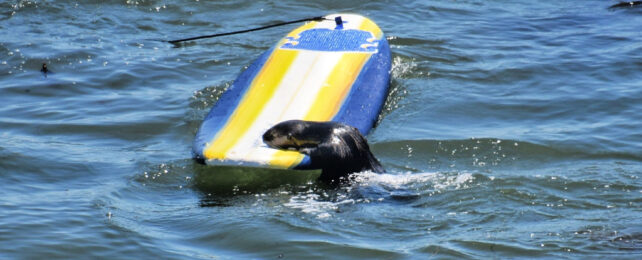Surfers often talk about how the sport helps them reconnect with nature, but a recent episode involving an otter with a love for surfboards shows just how brittle our love for wildlife really is.
The authorities are trying to capture and remove said otter from her native environment for climbing onto a man's surfboard in Santa Cruz, California. In a video of the incident published on Twitter, the otter is seen clambering onto the surfer's board where she appears to play with it.
Wildlife officials described the otter's behaviour as aggressive.
An amazing video!
— Native Santa Cruz (@NativeSantaCruz) July 10, 2023
This video of the sea otter attacking a surfboard yesterday was shared me and is being posted with the photographers permission. The video must remain in this tweet to be shared. This is a dangerous sea otter, avoid it if at all possible! pic.twitter.com/N7qPMFVRrt
People have joked that the otter has joined the orca uprising, referring to the killer whale attacks on boats off the coast of Spain. A researcher said the orcas are attacking sailboats for an "adrenaline shot".
If you watch the video, you will notice that the otter remains at the opposite end of the board to the surfer. But the language used by the media, and the authorities they quote, is far more telling than the otter's behaviour.
War on nature
We often use the language of combat to describe unusual events and to make sense of what seems like an imbalance in the world.
Words like "conflict" and "clash" fit into an oppositional narrative, which is a simpler way to tell stories than, say, "unusual interaction".
Often, as storytellers in all fields, we humans describe the world, our local environment and to whom they "belong", as a kind of fight – for example: "force of nature" and "triumph of civilisation".
Any number of things could explain the Santa Cruz otter's behaviour, including fear, anxiety, protective territorialism, curiosity and perhaps even aggression. People blame the otter, without stopping to think what our use of this space – their home – may mean to otters.
This particular otter may go through the trauma of being trapped, torn from her home and relocated. Yet it is the otter that is considered the aggressor.
The physicist and ecological philosopher Karen Barad urges us to rethink our interactions with the ecological world not as one of ownership or dominion, but entanglement.
She wrote that existence is not an individual affair and that people don't exist separately from their interactions with other beings. Individuals of any species live as part of an entangled existence with other living creatures.
Our connection to the natural world
Both otters and humans live in this watery coastal space in ways that are unique but intertwined. When our entanglement with nature becomes conflict, there will be casualties, which tend overwhelmingly to be the animals.
We impose human character traits, such as anger, onto animals without applying sensitivity to their motives. We reduce their complex experiences, feelings and cognition to a single action if they don't behave how we think they should (otters must be cute).
Think of cliches, such as "stubborn as a mule". Who wouldn't be stubborn under threat of whipping or while carrying a huge load?
We also borrow from nature for insults such as bitch, dozy cow and pig. We'll use these words to describe human qualities. But we don't stop to question the motivation behind animals' behaviour.
If we reverse the language in the news stories about the sea otter we could say the sea otter had her home invaded by a large, aggressive animal. And that animal's kin now wants to kidnap and incarcerate her.
The language of combat works for neither party. It doesn't work for the humans who impose it, because when you flip the language you ignore the fact humans are scared too, and confused because this animal they think of as cute and cuddly is turning against them.
People love otters, but western representation of otters has disconnected us from the random and varied complexities of their behaviour in nature.
We need to learn to share the Earth. And for that we need to change both our language and behaviour. Combat metaphors must be replaced with language about sharing and opening space for the animal.
This story reminds me of the childhood trauma of an entire generation who watched the beautiful film Ring of Bright Water (1969), where an otter is the star. This film is an interesting portrayal of the individuality of animals and how that conflicts with the way we reduce them to pests or nuisances.
Films and stories often use a distinctive animal or human character to remind us that each of Earth's occupants are individuals. Categorising animals as a species or other mass groupings is what makes us feel as though we can destroy them as "vermin" or "pests".
Are humans not pests to many animals just trying to thrive? The Evening Standard article ends with this quote from a marine expert: "They're actually pretty aggressive animals. They're not as cute and cuddly as people tend to think."
He could easily have been talking about humans.![]()
Patricia MacCormack, Professor of Continental Philosophy, Anglia Ruskin University.
This article is republished from The Conversation under a Creative Commons license. Read the original article.
